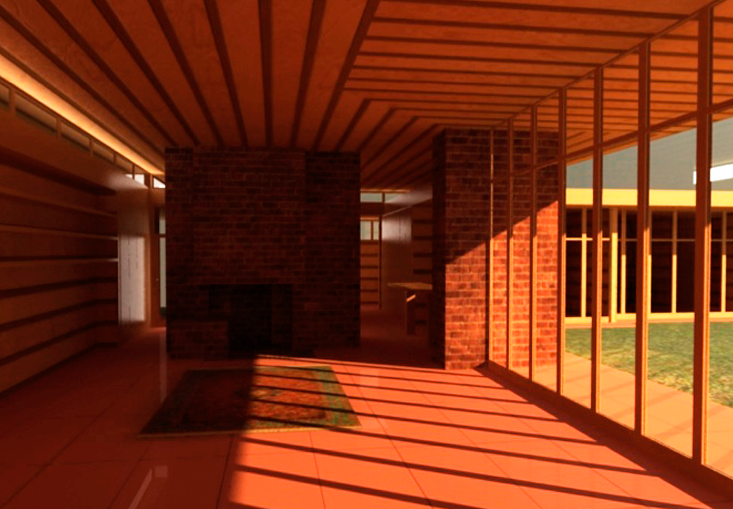Our interactions with home are intimate, sustained, complex, and even physiological. We react to them not just with our rational mind, and our emotions, but also with our bodies. To make matters more complicated, homes speak to socioeconomic status, and so are subject to a long list of expectations. In perhaps no other space do so many currents of our lives intersect and compete so directly.
What if there was a way to quantify our physiological reaction to the space we occupy? What would we discover about ourselves? That is exactly what my colleagues and I set out to do at my laboratory at the University of Waterloo, where we study physiological and emotional responses to simulated places. What we found is a strong, intrinsic, and consistent biological preference for a particular kind of space—and a consistent betrayal of this preference in final home-purchasing decisions. This betrayal shows that we bring to the spaces we live in, not just our selves, but our memories and expectations.
When you like something, your body quickly reacts to it in ways that you are not aware of. This is called arousal, and can include changes in heart rate, blood pressure, skin conductivity, sweat gland activity, and brain waves—each of which can be measured. At my laboratory, we measure these indicators while people wander through virtual homes designed with computer software, displayed in three dimensions on specialized headsets called head-mounted displays (HMDs). Participants are free to move around and, as they do so, motion-tracking equipment calculates their location, allowing the HMD to update the images they are seeing. (In reality, participants wandered through an empty gym.) All the while, we track their physiological response, to measure arousal, and eye movements, to see what they are paying attention to. Increased heart rate and skin conductivity indicates arousal, and a questionnaire asks participants to rate their feelings with words and numbers, distinguishing between positive and stress responses.
We presented three different virtual home spaces, which architects from Waterloo’s School of Architecture helped design. At left, a participant wears a virtual reality headset to wander through a virtual home. Experimenters, who are invisible to the participant, walk with him to operate equipment and interview him about his impressions.
One home was based on a design by Frank Lloyd Wright, known for creating home features that fostered feelings of warmth, security,
and comfort: Massive hearth spaces, alcoves with low ceilings that resembled protective caves, and the warm tones of natural materials such as wood. Wright’s designs tended to be modest and suitable for small middle-class families.
A second model was based on a home by Sarah Susanka, known for her efficient use of space in compact homes—as distinct from the emphasis on high square footage typical of Western architecture. Susanka is also known for her use of natural materials, such as wood for floors and stone for countertops. A third model was based on a nearby house—a typical cookie-cutter North American suburban design.

The virtual home models proved to be compellingly immersive. We watched our participants duck under kitchen cabinets, peer into sinks and bathtubs, and linger in their favorite places. One participant noted that as she walked past a virtual sunlit window, she felt the warmth of the sun on her arms—while in reality she was standing in a windowless room with concrete walls.
In these convincing artificial environments, we observed a remarkable consistency of response across gender, class, and cultural categories. For example, when asked where in the houses they would like to carry out a given task, most participants converged on the same answers: Small spaces for decision-making, and open places for social activities. This consistency pointed to a deep-seated biological origin for these preferences. Even more surprising was the consistency in preference for the cookie-cutter design. About 70 percent of participants said they’d buy the typical North American suburban house, despite the fact that the other two models evoked the most positive physiological responses. Half of these 70 percent attributed their preference to the fact that the cookie-cutter house would be the most likely of the three to be found on the market. Another 12 percent said that this house seemed best suited to their lifestyle. Others seemed uncertain about the basis for their choice.

This fracture between measured comfort and positive affect on the one hand, and the participants’ actual decision on the other, is puzzling, and the participants’ own responses provide only an uncertain guide. Do we lose faith in our feelings and emotions and become pragmatic realists in the face of the largest financial decision of our lifetime? Or are our aesthetic or physiological responses overcome by personal histories and expectations? Is there yet another psychological reason? Our experiment, still underway, cannot yet tease apart such possibilities, but a different project—the study of the feelings generated by city streetscapes—suggests that personal history may play a key role.
When we measure the responses of visitors to real places on city streets, using methods similar to those in our house experiment, we find that first-time visitors respond to sensory properties such as immediately graspable sights, sounds, and smells. This roughly corresponds to the physiological response we observed in our virtual homes. But frequent visitors respond more to their memories of the place, and sensory input becomes less important. This suggests that, when we encounter a new space, we try to merge what we see with what we remember, sometimes subconsciously. This merger can overcome even the world’s best design work.
This is exactly what happened to me. When I was in the hunt for my own new home, my real estate agent assured me that I’d “know it when I saw it.” But the seemingly identical, nondescript suburban houses we saw let the impression of living containers, rather than homes. They all had the essential features, but they were lifeless and flat. They were not me. Not us.
When I was close to abandoning hope, a tiny picture of a listed house struck a chord. It looked right, like a friendly face in a crowd of unapproachable strangers. There was an offer on it already. “If you want it, you’ll need to make an offer right away,” my agent said.
When we walked in, I was greeted by a long sight line from the threshold, past a warm and inviting living room with a fireplace on my right, through a small kitchen, and out into a room that had been added to the back. I loved that the house, built almost 100 years ago, was airy, with high ceilings and careful attention to trim. I loved that it was not an open concept design in which all the functions of a home reside in one large, cavernous space. I loved the small nooks that signaled privacy and larger open spaces perfect for socializing and family time.
There were two processes at work. My analytic mind was counting bedrooms and making measurements, making sure my large family of six would fit. At the same time, I felt a rising emotional response to the house, including a flight of memories of other homes I’d known. I felt a primal attachment to the space—I wanted to throw off my coat, settle into a chair, and kick out the current owners. This was my home. Within 15 minutes of passing the front door, I signed a no-holds barred, above-asking-price, unconditional offer and wrote out a sizable check. The fact that I wasn’t sure I could afford this mortgage didn’t faze me in the least. I waited nervously for the verdict from the owners, and when my agent emerged with a broad smile on her face, I felt a triumphant rush of happiness. I had found my home.
Where did this feeling come from? At the time, I didn’t know. Then, about two years ago, partly out of professional curiosity, but also as part of a personal quest engendered by epochal changes in my life—a divorce after a long marriage—I embarked on a kind of pilgrimage. I decided to re-visit all of the homes I’d ever lived in, starting with my birth house in England and working my way through three continents and dozens of dwellings.
In the suburbs of London, I visited the home I’d lived in for the first few years of my life—and was gripped by a strange sense of familiarity. I looked down a long sight line from the threshold to the small kitchen and beyond it to a newer room added to the house after it was built. I looked to my right and saw a compact living room with a beautiful fireplace. I ascended the stairs and found three small bedrooms. I realized then that the layout, the scale, the connections between rooms, and even the size and shape of the yard were a mirror image of the house I had bought in Canada.
Without realizing it, I’d served as a powerful single-case study. We are instinctively driven to houses that satisfy certain aesthetic and inbuilt biological desires—but also, and perhaps even more strongly, to houses that evoke happy memories. I immediately fell in love with my current house because I’d already lived in it as a happy little child in another place and another century. Years later, an ocean and a lifetime away, I’d stumbled upon home again.
Colin Ellard is a cognitive neuroscientist and director of the Research Laboratory for Immersive Virtual Environments at the University of Waterloo in Canada. He is the author of You Are Here, a book about the psychology and neuroscience of the built environment.




























